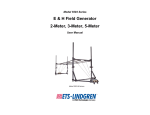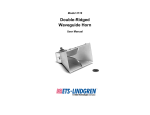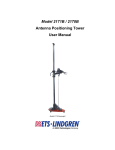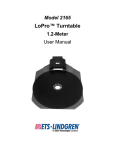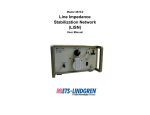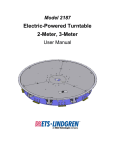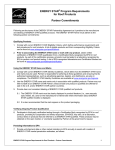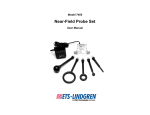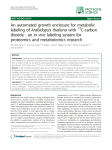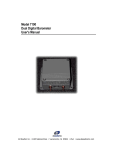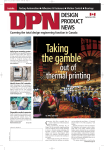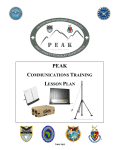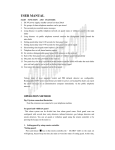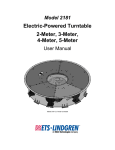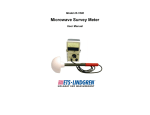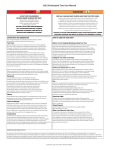Download Model 2175 MiniMast™ User Manual - ETS
Transcript
Model 2175 MiniMast™ User Manual ETS-Lindgren L.P. reserves the right to make changes to any products herein to improve functioning or design. Although the information in this document has been carefully reviewed and is believed to be reliable, ETS-Lindgren does not assume any liability arising out of the application or use of any product or circuit described herein; nor does it convey any license under its patent rights nor the rights of others. All trademarks are the property of their respective owners. © Copyright 2005–2008 by ETS-Lindgren L.P. All Rights Reserved. No part of this document may be copied by any means without written permission from ETS-Lindgren L.P. Trademarks used in this document: The ETS-Lindgren logo and MiniMast are trademarks of ETS-Lindgren L.P. Revision Record | Model 2175 MiniMast, MANUAL | Part #399770, Rev. C Revision ii Description Date A Initial Release April, 2005 B Updates November, 2005 C Design updates; rebrand September, 2008 | Table of Contents Notes, Cautions, and Warnings ......................................................................... v 1.0 Introduction ................................................................................................... 7 Standard Configuration ............................................................................................................. 8 Optional Items ........................................................................................................................... 9 ETS-Lindgren Product Information Bulletin .............................................................................. 9 2.0 Maintenance ................................................................................................ 11 Maintenance Recommendations ............................................................................................ 11 Routine Check .................................................................................................................. 11 Six-Month Check .............................................................................................................. 12 Replacement and Optional Parts ............................................................................................ 12 Service Procedures ................................................................................................................. 12 3.0 Specifications.............................................................................................. 13 Electrical Specifications .......................................................................................................... 13 Physical Specifications............................................................................................................ 13 4.0 Assembly and Installation .......................................................................... 15 Product Assembly ................................................................................................................... 16 Electrical Installation ............................................................................................................... 23 Connecting the Controller ....................................................................................................... 24 Carrier Safety Brake................................................................................................................ 25 5.0 Operation ..................................................................................................... 27 Editing the Controller Configuration Parameters .................................................................... 27 MiniMast Encoder Calibration ................................................................................................. 27 Antenna Mounting Instructions ............................................................................................... 28 Pre-Operational Checks .......................................................................................................... 30 Start-Up and Safe Shutdown .................................................................................................. 30 Infrared (IR) Controller ............................................................................................................ 30 Appendix A: Warranty ...................................................................................... 33 Appendix B: Drawings ...................................................................................... 35 Appendix C: EC Declaration of Conformity .................................................... 37 | iii This page intentionally left blank. iv | Notes, Cautions, and Warnings Note: Denotes helpful information intended to provide tips for better use of the product. Caution: Denotes a hazard. Failure to follow instructions could result in minor personal injury and/or property damage. Included text gives proper procedures. Warning: Denotes a hazard. Failure to follow instructions could result in SEVERE personal injury and/or property damage. Included text gives proper procedures. See the ETS-Lindgren Product Information Bulletin for safety, regulatory, and other product marking information. | v This page intentionally left blank. vi | 1.0 Introduction The ETS-Lindgren Model 2175 MiniMast™ is a portable, electric-powered mast and platform system designed to be used with the Model 2090 Multi-Device Controller (or next generation ETS-Lindgren controller, if applicable) for EMI compliance testing. The MiniMast is designed for antenna scanning from 1 meter to 4 meters. The mast, carrier, platform, lifting rope, and guying system are non-conductive and non-magnetic. The mast section is constructed of square fiberglass tubing for strength, rigidity, and “weatherability”. The MiniMast may also be manufactured in custom mast heights. Contact your local sales representative for additional information regarding custom height. The MiniMast features an offset boom that maintains a constant rotational axis along the centerline when the antenna is rotated from horizontal to vertical polarization. A cable guide at the back end of the boom feeds the coaxial cable to the antenna while maintaining the appropriate bending radius. The air polarization feature allows for remote polarization of the antenna using the controller or the infrared remote control. For antennas with a stinger mount, the offset boom can be removed. The antenna stinger is then clamped into the mounting block using the hand knob. Introduction | 7 The antenna carrier is raised and lowered by a fractional horsepower, electric, variable speed motor. A worm-type gearbox driven by the motor provides the adequate torque needed to raise and lower the carrier and prevents the carrier from back-driving the motor. The motor and associated electronics are contained in a shielded enclosure mounted beneath the platform of the unit. Under command of the controller, the motor typically positions the carrier within one centimeter of the desired location. To prevent over travel of the carrier in either direction of movement, the mast system has integral fiber optic limits. Soft limits may be set within the travel range provided by the mechanical limits using the controller. The motor base is connected to the controller through a twin fiber optic cable assembly. This fiber optic cable transmits both directional control and position information. Power to the motor base is provided locally to the motor through a detachable, grounded power cable. A carrier brake is mounted on the carrier assembly. In the event that the carrier is released from the rope suspension, a spring-loaded cam locks the brake into position against the mast and locks the carrier so that further vertical movement is restricted. The carrier brake is intended to provide some protection to the carrier and the antenna; it is not a fail-safe brake for protection to personnel. Personnel operating this equipment should be instructed to stay clear of the carrier and boom at all times whether or not the carrier is moving. Polypropylene braided rope guy lines are provided for installations requiring the mast to be guyed and must be firmly anchored for vertical stability. Use of the guy lines is recommended in all applications to provide maximum stability. Standard Configuration 8 • Motor, 220 VAC, nominal • Input frequency 50 or 60 Hz • Tower platform casters for movement of the unit • Offset antenna mount • Stinger antenna mount • 10-meter fiber optic control cable for inside chamber | Introduction • 3-meter fiber optic control cable for connection to Model 2090 controller (or next generation ETS-Lindgren controller, if applicable) outside chamber • Two ST-to-ST bulkhead feedthroughs provide a means to penetrate a shield wall and maintain the integrity of the shielded enclosure • Air polarization (adjustable speed) • Infrared (IR) Remote Optional Items • Model 2090 Multi-Device Controller (or next generation ETS-Lindgren controller, if applicable): This controller provides control for two separate devices (for example, towers and turntables) in any combination, plus the control of four auxiliary devices through a fiber optic interface. The unit includes a GPIB connection and is compatible with most popular EMI measurement software. • Universal Antenna Mount: This option is a versatile and sturdy mount for most common antennas. • Additional Fiber Optic Cable: Various lengths of fiber optic cable are available by custom order. ETS-Lindgren Product Information Bulletin See the ETS-Lindgren Product Information Bulletin included with your shipment for the following: • Warranty information • Safety, regulatory, and other product marking information • Steps to receive your shipment • Steps to return a component for service • ETS Lindgren calibration service • ETS Lindgren contact information Introduction | 9 This page intentionally left blank. 10 | Introduction 2.0 Maintenance Before performing any maintenance, follow the safety information in the ETS-Lindgren Product Information Bulletin included with your shipment. Warranty may be void if maintenance is performed incorrectly. Maintenance of the Model 2175 MiniMast™ is limited to external components such as cables or connectors. If you have any questions concerning maintenance, contact ETS-Lindgren Customer Service. Maintenance Recommendations Regular maintenance will prolong the service of your mast assembly. If excessive wear or damage is found during any of the recommended checks, the system must be taken out of service and repaired before proceeding. Pneumatic tubing that appears to be brittle and worn from the effects of UV radiation and inclement weather should be replaced. Lubricant may be purchased from ETS-Lindgren; contact the Sales Department at +1-512-531-6400 and request item #890437. Before performing any maintenance, disconnect the unit and turn off power. ROUTINE CHECK • Prior to beginning normal operation of the mast, check the mast and lift system for any signs of damage or excessive wear. • Checks the lift rope for excessive wear. • Check the mast and carrier for any signs of damage or excessive wear. • Check the guy line(s) to ensure safe and secure and check for excessive wear. • Verify the height readout of the controller and the physical position of the mast are the same. • Verify the antenna is secure. • Check routing of all cables to make sure they do not interfere with the operation of the mast. Maintenance | 11 SIX-MONTH CHECK • Check the lift rope and guy line for signs of wear. • Inspect the components and tubing of the pneumatic polarization mechanism for signs of corrosion, excessive moisture, and wear. • Lubricate the air cylinder O-rings to prevent excessive wear. • Check all cabling to the motor base for frayed and worn insulation. Replacement and Optional Parts See the drawings located in the back pocket of this manual for the part numbers to order replacement or optional parts for the MiniMast. Service Procedures For the steps to return a system or system component to ETS-Lindgren for service, see the Product Information Bulletin included with your shipment. 12 | Maintenance 3.0 Specifications Electrical Specifications Nominal AC Voltage 220 VAC Input Frequency 50/60 Hz Current Rating 10 Amp service Phase Single Physical Specifications Base Dimensions 0.90 m x 0.90 m 2.95 ft x 2.95 ft Weight 81.2 kg (179.0 lb) Overall Height 4.61 m (15.1 ft) Mast Height Nominal 4.5 meters 4 meters standard Scan Range Custom height may be specified upon placement of order Required Air Pressure 60-80 psi (410-550 kPa) Carrier Load Rating Not to exceed 18 kg (40 ft lb) 10 kg (22 lb) Maximum Loading See Operation on page 27 for additional information Specifications | 13 This page intentionally left blank. 14 | Specifications 4.0 Assembly and Installation Before connecting any components, follow the safety information in the ETS-Lindgren Product Information Bulletin included with your shipment. The Model 2175 MiniMast™ is shipped partially assembled; the assembly process will take approximately one hour. Ensure that a clear area is available to unpack and assemble the MiniMast. Prior to starting the assembly process, open the shipping container and check all parts for any shipping damage. Do not discard any packing material until the MiniMast is fully installed and operation. During this assembly procedure, refer to the illustrations provided for each step. Tools needed for assembly (included with shipment): • Adjustable open-end wrench • Phillips head #2 screwdriver Figure 1: Tools shipped with MiniMast Assembly and Installation | 15 Product Assembly 1. Attaching the motor is the first step of the assembly process. Locate the motor in the packaging under the positioner base. Lay the motor with the winch drum facing the direction of the slot provided in the base. Roll the platform over the top of the motor and find the brackets under the platform that pin the motor into position. Tabs on motor slide between the brackets on the platform. Figure 2: Motor attached to bottom of MiniMast 2. Lift slightly on the motor and insert the pins provided to secure the motor in position. Once pinned into position, the platform and motor together may be placed on one side to connect the air hoses from the platform to the motor base. After the air hoses are connected lay the positioner platform back into position with the casters on the floor. 16 | Assembly and Installation 3. Continuing with the assembly, insert the mast into the support angles on the platform. An axle bushing with stud and nuts for securing in place is on the platform. Carefully remove the fiber optic cable packed into the lower end of the mast and straighten the leads. Insert the mast between the two angle supports in approximately the correct position. Insert the mast axle. After the axle is in place, route the fiber optic limit cables through the fiber optic hole provided in the platform. Do not damage the fiber optic cable during this step. Make sure it is out of the way when inserting the mast axle through the mast. Figure 3: Fiber Optic Placement 4. Place the carrier and top cap into the position shown on the mast. Verify that the carrier brake engages the corner of the mast and all components are oriented as shown in the following picture. The top cap of the mast bolts into place with an axle nut and a threaded fiberglass stud and nut combination. Securely tighten the nut and stud to secure the top cap. The stud should be flush with the nut when tightened in the proper position. Uncoil the guy ropes and let them hang unobstructed. Assembly and Installation | 17 Figure 4: Securing the Mast Cap 5. Unwind the rope from the winch drum and feed it over the pulleys so that the free end lines up with the clamp on the carrier brake assembly. Feed the rope through the clamp on the brake assembly and tighten clamp nuts hand tight. Further adjustment will be necessary once the mast is completely assembled. Figure 5: 18 | Pulley Location Assembly and Installation Figure 6: Screw Placement 6. The mast brackets should be installed according to the orientation shown in previous illustrations. Using the #2 Phillips screwdriver provided, tighten the screws through the large and small mast brackets through the mast and into the nut plate that is already fitted with inserts. 7. Engage the brakes on the swivel casters of the platform so that they will not roll. Carefully raise the mast to a vertical position and insert the lock pin provided to hold it in place. Do not attempt the next portion of the assembly with less than two people. Care should be taken to keep the carrier from contacting the platform during this procedure so that it cannot damage the platform. 8. Leaving approximately one turn of rope on the winch drum, pull the hoisting rope tight through the clamp block on the brake. Once the clamp is fully tightened onto the rope, tie a loose half-knot on the mast side of the clamp to make sure the rope does not slip back through the clamp. Once this is accomplished, wind the excess rope around the clamp portion of the brake so that the brake still functions correctly and the rope does not interfere with the carrier working properly. 9. Attach the free end of the guy lines to anchors located on the ground plane or within the chamber. Assembly and Installation | 19 Outdoor applications require guying to stabilize the mast against wind. For outdoor applications, engage the lock on the swivel casters at this time. Figure 7: Boom Placement 10. Pull the coiled hose out of the carrier and insert the primary boom as pictured into the carrier. Note the position of the knobs on the boom gear and on the boom bearings. The gear back-up roller should be directly behind the rack gear and the cylinder should be in a fully compressed state. Incorrect horizontal and vertical polarization angles will result if the cylinder is not fully compressed. Once the primary boom is locked in place, install the offset boom and the coaxial cable strain relief. 20 | Assembly and Installation LOCATION OF CONNECTIONS Assembly and Installation | 21 LOCATION OF CONNECTIONS, CONTINUED Figure 8: Location of Connections 11. Coiled hoses that were located inside the carrier should be connected to the fittings on the platform for the polarization to become operable. All connections to the motor base should be completed at this time including fiber optic limits and control lines, along with compressed air and electrical power. Route all connections through the connection entry on the platform tube so they will exit through the connection exit. Install the platform end covers by positioning and applying pressure to secure them in place. Check to see that the controller reads horizontal polarization. 22 | Assembly and Installation 12. Slightly engage the air lines onto the fittings and note the position of the boom. Energize the air line supply to the motor base. If the boom is in horizontal polarization (holes in the boom are on top), fully engage the hoses onto the fittings provided. If the boom is in vertical polarization, turn the air off and reverse the air lines and then fully engage them on the fittings provided in the platform. Air line pressure should be between 60–80 psi (4.14–5.52 bar). Do not exceed 80 psi (5.52 bar). Keep hands away from any portion of the carrier while performing this task. Failure to do so may result in personal injury. Do not perform any service on the carrier with the air lines energized. 13. When the MiniMast is in the position where testing will occur, lock the brakes provided on the swivel casters to prevent movement of the platform. Electrical Installation The motor base is provided with a three-conductor AC power cord that is approximately 2.45m (8 ft) long. Power to the motor base is 220 VAC. The motor base should be wired to a circuit capable of providing 10 amps of service. The power cord is to be terminated into an outlet near the motor base. The power cord is suitable for portable or indoor applications without modification. Ideally, the power cord would exit the motor base and terminate into an outlet with as short a cord as possible as the start and stop actions of the motor base create a small amount of RF noise through the power cord. If this equipment is to be operated outdoors, precautions must be taken to protect the MiniMast from the weather. In the event that modifications are required, the installation should be compliant with all local and national electrical safety codes. As with all electrical devices, disconnect the power prior to servicing the equipment. A fuse is mounted on the side of the motor enclosure. This fuse provides protection for the motor and the associated electronics. An additional fuse provides protection for the DC power supply inside the motor base. Assembly and Installation | 23 The branch circuit supplying power to the motor base should be protected from excess current according to local electrical codes. Whenever possible the motor should be powered from a separate branch circuit of adequate current capacity to keep voltage drop to a minimum during startup and running. Check that the conductor size is adequate for the motor load and the distance from the mains source. Improperly sized conductors will lead to a high voltage drop in the power conductors and cause reduced starting torque and premature motor failure. For longer runs, increase the wire size in accordance with the wire selection guide shown below. When considering what gauge of wire to use, never use smaller than 14 AWG for any installation. Length of wire @220V Wire gauge required 0–15.24 m (0–50 ft) 15.24–30.48 m (50–100 ft) 30.45–60.96 m (100–200 ft) 14 AWG 14 AWG 14 AWG Connecting the Controller Any combination of devices may be connected to the two device interface ports located on the rear panel of the Model 2090 Multi-Device Controller (or next generation ETS-Lindgren controller, if applicable). The default settings are for a tower connected to the Device 1 interface port and a turntable connected to the Device 2 port. Fiber optic cabling for each device should not be allowed to hang unsupported from the rear panel of the controller. The fibers and connectors are easily broken if twisted or bent. Keep the fiber optic cables as straight as possible from the connector to the protective sheath. Device connection is accomplished with a dual fiber optic cable included with the device. This cable terminates into two ST connectors that are identical at both ends. The cable is symmetrical; either end can be connected to the controller. A fiber optic cable that connects to the IN port of a controller should, at the other end, be connected to the OUT port of the motor base. A fiber optic cable connected to the OUT port of the controller should, at the other end, be connected to the IN port of the motor base. The fiber optic mechanical limits must be set before the carrier is able to move. 24 | Assembly and Installation Carrier Safety Brake A safety brake is mounted on the carrier assembly. In the event that the carrier is released from the rope suspension, a spring-loaded cam jams the brake into position against the mast and slows the vertical movement of the carrier. The safety brake is not intended to completely restrict movement of the carrier. Always exercise extreme caution when the safety brake is engaged. To release the carrier safety brake, support the carrier and release the brake roller. Slide the carrier down to the base of the mast. Replace the carrier rope if necessary. Reset the current position using the controller before resuming use of the mast. Assembly and Installation | 25 This page intentionally left blank. 26 | Assembly and Installation 5.0 Operation Before connecting any components, follow the safety information in the ETS-Lindgren Product Information Bulletin included with your shipment. See the Model 2090 Multi-Device Controller (or next generation ETS-Lindgren controller, if applicable) manual if you are unfamiliar with the operation of the unit. A manual is included with each controller shipment and is also available for download from www.ets-lindgren.com. Editing the Controller Configuration Parameters See the Model 2090 Multi-Device Controller (or next generation ETS-Lindgren controller, if applicable) manual for steps to edit the configuration parameters. MiniMast Encoder Calibration The display symbol C refers to the encoder calibration parameter. This setting is used to convert the encoder count values returned from a motor base into the corresponding centimeter or degree position reading. For towers, the number represents the number of encoder counts per meter. Using this parameter, a variety of standard, retrofit, and custom devices can be used. The setting for the Model 2175 MiniMast™ is 2000. If the given value does not appear to work correctly, the encoder calibration value can be determined using the following procedure: 1. Set the encoder calibration value to 1000. 2. Ensure that the MiniMast is positioned to allow at least one meter of travel in the upward direction at an easily measurable height, then set the current position reading to 000.0. You must adjust the lower limit setting to allow at least one meter of travel. 3. Using the STEP keys of the controller, adjust the height of the carrier until it is one meter above the start point. 4. Record the reading of the display, ignoring the decimal point (for example, 200.0 would be 2000). This is the encoder calibration value. Operation | 27 If the value is below 1000, the resolution of the encoder is low and the controller will not provide 0.1 cm resolution, even though the display shows that digit. If the value has gone past 9999, the encoder has too many counts per meter and the controller cannot correct for it. In this case, contact ETS-Lindgren for assistance. 5. Enter this value for the encoder calibration value and reset the limits and position information. 6. Test the MiniMast by moving it to a known distance and comparing the display to the measured distance traveled. It may be necessary to adjust the encoder calibration value up or down slightly depending on the result. Antenna Mounting Instructions Antennas may be mounted to the assembly using either the 7/8–14 thread which is common on ETS-Lindgren brand antennas, or the 1/4–20 thread which is another common size. The antenna should be mounted on the boom as close to the carrier as possible. Insert the mounting knobs through the holes on the boom and align the mounting holes on the antenna with the threaded end of the mounting knobs. Secure the antenna in place by tightening the threaded knobs into the receptacle mounting holes on the antenna. Antennas may also be mounted using the stinger mount adapter included with the assembly. 28 | Operation Figure 9: Boom Load Limitations Operation | 29 Pre-Operational Checks • Verify that the power lines are connected to the motor base for the MiniMast, controller, and any other equipment that will be used to test. • Verify the fiber optic cables are connected to the motor base. • Verify the limit fibers are connected to the motor base. • Verify the antenna connected to the boom is securely mounted in place. • Connect the feed cable to the antenna. • Verify the load of the antenna is within the operating specifications. Before moving the carrier on the mast up or down using the controller or the IR remote, make sure no one is standing near the boom. Start-Up and Safe Shutdown After completing the pre-operational checks, the controller may be turned on by pressing the power button. See the Model 2090 Multi-Device Controller (or next generation ETS-Lindgren controller, if applicable) manual for operating instructions. Prior to shutting the MiniMast down, move the carrier to an accessible height for the removal of the antenna. Make sure the unit has come to a complete stop. Press the power button on the controller to turn it off. Finally, remove power from the MiniMast. Infrared (IR) Controller The motor base features an infrared receiver that will respond to a universal remote control programmed to a specific protocol. Any remote that continuously transmits and contains the proper TV protocol can be used. The basic functions supported are as follows: Button 30 | Command Power Emergency Stop Channel Up Up for linear positioner Channel Down Down for linear positioner Operation Button Volume Left Command Volume Right Counterclockwise for rotational positioner Clockwise for rotational positioner Mode Polarization for linear positioner Operation | 31 This page intentionally left blank. 32 | Operation Appendix A: Warranty See the Product Information Bulletin included with your shipment for the complete ETS-Lindgren warranty for your Model 2175 MiniMast™. DURATION OF WARRANTIES FOR THE MINIMAST All product warranties, except the warranty of title, and all remedies for warranty failures are limited to two years. Product Warranted Duration of Warranty Period Model 2175 MiniMast 2 Years Warranty | 33 This page intentionally left blank. 34 | Warranty Appendix B: Drawings These drawings are included in the pocket located on the back cover of the manual: • 108983, Crossboom • 109276, 2175 Carrier • 109356, 2175 Positioner (2 pages) Drawings | 35 This page intentionally left blank. 36 | Drawings Appendix C: EC Declaration of Conformity EC Declaration of Conformity | 37 REF DRAWING REVISIONS ECO# NOTES: 1) CUT ROPE 1 EA. 29.5 FT. BURN ENDS AND INSTALL ON WINCH DRUM. TAPE TO HOLD IN PLACE FOR SHIPPING. 2) CUT ROPE 3 EA. 18 FEET. BURN ENDS AND INSTALL IN HOLES PROVIDED IN MAST CAP FOR GUYING. REV 5120 B DESCRIPTION CHANGED ROPE DATE APPROVED 09/14/06 SRK 6 2X APPLY TAPE TO FULL WIDTH OF BASE AND THEN APPLY 1" LENGHTS EQUALLY SPACED, 6" ON CENTER TO CLOSURE. 17 34.25 34.50 C D 4 4486.28 176.63 7 A 18 B 6 8 ATTACH TWIN HOSE TO FITTINGS ON AIR CYLINDER. 17 UNLESS OTHERWISE SPECIFIED: DIMENSIONS ARE IN INCHES TOLERANCES ARE: DECIMALS ANGLES X.XX ± .015 X.XXX ± .005 ± .5 CHECKED NONE DATE SRK 12/12/04 RG 2/4/05 MATERIAL FINISH TAPE,RECLOSABLE,250 STEMS/IN, I IN. WIDTH 8 40 910899 NUT,5/8-11,FG,BROWN 1 39 910686 SCREW,10-32 X 1/2,PHIL,FLAT,SS 4 38 910455 WASHER,1/4,FLAT,SS 5 37 910451 BOLT,1/4-20 X 1-3/4,HEX,SS 5 36 910357 SCREW,10-32 X 3/4,PHIL,BIND,SS 6 35 910331 SCREW,10-32 X 1/2,PHIL,BIND,SS 9 34 910269 NUT,8-32,HEX,SS 2 33 905194 COUPLING,BULKHEAD,1/8 NPT 2 32 890983 SLEEVING,SLIT-CONVOLUTED,PE,1/4" ID(NOT SHOWN) 23 31 890971 PIN,3/16 X 1" QUICK RELEASE 3 30 890951 PIN,1/2 X 5 GRIP LENGTH,SST 1 29 890950 FITTING,TUBE,1/8 NPT TO .17 ID,RT ANGLE 2 28 890947 HOSE,TWIN,1/8 ID X 1/4 OD,COILED,20 FT 1 27 890946 BUSHING,3/8 ID X 5/8 OD X 3/8,GRAPHITE 2 26 890797 BUMPER,.75 OD,.5 HT,#8 SCREW 2 25 890465 BARB HOSE 11924-1 CLIPPARD 4 24 890464 NUT TUBE 5000-2 CLIPPARD 4 23 860314 ROPE,3/16,2300 LBS 83.5 21 860140 TUBE,1/4 O.D. X .047 W.T.,NYLON,BLK 6.5 20 708041 FIBER OPTIC CABLE LIMIT SWITCH 6.5M(NOT SHOWN) 2 19 708040 FIBER OPTIC CABLE LIMIT SWITCH 1.5M(NOT SHOWN) 2 18 109363 LENSE,INFARED,1" X 8" 1 17 109362 BASE,ASSEMBLED,2175 1 16 109355 NUT,MAST CAP,2175 1 15 109354 PLATE,NUT,2" MAST 1 14 109353 BRKT 2,MINIMAST 1 13 109352 BRKT 1,MINIMAST 1 12 109285 BRKT,PIN MOUNT 3 11 109284 BRKT 2,MOTOR MOUNT 3 10 109283 BRKT 1,MOTOR MOUNT 3 9 109282 STUD,5/8-11 X 4,FG 1 8 109277 MOTORBASE,2175 1 7 109276 CARRIER,2175 1 6 109274 CLOSURE,BASE,2175 2 5 109272 CAP,MAST,2175 1 4 109271 MAST,2-1/8" X 4 METER,2175 1 3 109252 LIMIT,F.O. ASSEMBLY 2 2 108963 AXLE,ROPE PULLEY,3/8 DIA. 2 1 108962 PULLEY,2-5/16 MEAN DIA.,3/16 ROPE 2 DESCRIPTION Default/QTY. PART NUMBER EMC Test Systems, L.P. Cedar Park, TX APPROVALS DRAWN 920300 ITEM NO. E 22 41 SEE BOM ETS LINDGREN TM An ESCO Technologies Company Lindgren-RF Enclosures Glendale Hts, IL TITLE POSITIONER,2175 PROPRIETARY INFORMATION ANY DUPLICATION OF THIS DOCUMENT, WHOLE OR IN PART, WITHOUT EXPRESS WRITTEN PERMISSION OF ETS LINDGREN IS PROHIBITED. SIZE SCALE D 1:16 DWG. NO. DO NOT SCALE DRAWING REV. 109356 SHEET 1 OF B 2 REF DRAWING REVISIONS ECO# NOTES: REV 5120 37 38 B DESCRIPTION CHANGED ROPE DATE APPROVED 09/14/06 SRK 10 31 TWIN HOSE ATTACHES HERE. 11 24 25 12 33 35 DETAIL B SCALE 1 : 2 40 9 5 1 27 2 29 16 DETAIL C SCALE 1 : 2 DETAIL E SCALE 1 : 1 39 36 13 14 3 30 DETAIL D SCALE 1 : 2 EMC Test Systems, L.P. Cedar Park, TX 26 DETAIL A SCALE 1 : 2 34 UNLESS OTHERWISE SPECIFIED: DIMENSIONS ARE IN INCHES TOLERANCES ARE: DECIMALS ANGLES X.XX ± .015 X.XXX ± .005 ± .5 APPROVALS DRAWN CHECKED SRK 12/12/04 RG 2/4/05 MATERIAL FINISH NONE DATE SEE BOM ETS LINDGREN TM An ESCO Technologies Company Lindgren-RF Enclosures Glendale Hts, IL TITLE POSITIONER,2175 PROPRIETARY INFORMATION ANY DUPLICATION OF THIS DOCUMENT, WHOLE OR IN PART, WITHOUT EXPRESS WRITTEN PERMISSION OF ETS LINDGREN IS PROHIBITED. SIZE SCALE D 1:20 DWG. NO. DO NOT SCALE DRAWING REV. 109356 SHEET 2 OF B 2









































